Succulents, with their enchanting allure and minimal care requirements, have blossomed into a favored choice for indoor and outdoor gardens alike. Picture a serene garden, where succulent leaves gracefully dance in the breeze, adding a touch of tranquility to your space. However, amidst this botanical symphony, a common concern has surfaced among succulent enthusiasts—the mysterious occurrence of succulent leaves falling off. If you find yourself caught in contemplation over this verdant enigma, fear not! This article will harmoniously guide you through the labyrinth of succulent care, Exploring why these Succulent leaves may say a gentle goodbye.
Understanding Succulent Anatomy
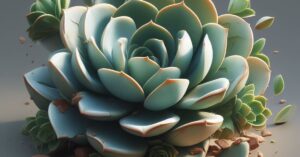
Succulents, with their fascinating array of shapes and colors, captivate enthusiasts worldwide. However, to comprehend why succulent leaves may be falling off, it’s essential to delve into the intricacies of their anatomy. Succulents are well-adapted to arid environments, storing water in various structures, most notably their leaves. These thick, fleshy leaves serve multiple functions, playing a crucial role in water retention, photosynthesis, and maintaining the plant’s structural integrity.
Environmental Factors
Light Exposure and Succulent Leaf Health
he initial key to demystifying the phenomenon of succulent leaf loss lies in orchestrating their delicate dance with light. Succulents, with their love for bright, indirect sunlight reminiscent of their native havens, create a symphony of hues and shapes in well-lit environments. Yet, too much direct sunlight can disrupt this harmony, leading to the somber notes of succulent leaves falling off, a silent ode to sunburn and irreversible damage.

To compose the perfect melody for your succulents, assess the light conditions they encounter. Inadequate light may compose a melancholic tune, with stems elongating and weakening, while the crescendo of excessive sunlight can scorch the leaves, creating dissonance in your botanical ensemble. Find the harmonious spot for your succulents, offering them a stage bathed in ample sunlight without exposing them to the harsh rays of a solar spotlight.
For indoor succulents, a south-facing window often unveils the ideal compromise, casting a gentle spotlight on their verdant performance. Outdoor succulents, on the other hand, may seek refuge in the partial shade during scorching afternoon crescendos. Observe the intricate choreography of your succulents’ response to light conditions, a vital act in maintaining the vitality of their foliage.
As we continue our melodic journey through the various environmental factors that sway succulent health, the next movement to explore is the subtle impact of temperature on their graceful performance.
Temperature and its Impact on Succulent Leaves Falling Off
In the enchanting saga of succulents, their roots firmly planted in arid and semi-arid realms, temperature becomes a lyrical thread weaving through their verdant tapestry. Like skilled musicians, succulents thrive in temperatures that echo the rhythms of their native environments. Yet, the discordant notes of succulent leaves falling off may strike when faced with temperature extremes, whether it be the blazing heat of noon or the chilly grasp of a frosty night.
Compose a symphony of care attuned to your location’s climate, ensuring your succulents dance to the right temperature. In colder domains, protect these botanical performers from the frosty chill by ushering them indoors or providing a cozy shelter. Meanwhile, in scorching climates, cast a gentle shade upon them during the intense afternoon sun, shielding them from the risk of overheating.
Maintaining the perfect temperature crescendo between 60°F to 75°F (15°C to 24°C) typically orchestrates the ideal harmony for most succulent varieties. Regularly tuning into your succulents’ response to temperature fluctuations acts as a vigilant conductor, guiding the ensemble away from the melancholy of succulent leaves falling off.
As our melodious exploration of environmental factors continues, let us now immerse ourselves in the atmospheric notes of humidity and its role in the delicate choreography of succulent care.
Humidity Levels and Succulent Care

In the rhythmic dance of succulents, finely tuned to the arid symphony, humidity emerges as a subtle note in the botanical melody. These resilient plants, masters of adaptation, thrive in low humidity environments. However, the crescendo of high humidity can introduce dissonance, creating a fertile ground for fungal issues and disrupting the delicate moisture balance within succulent leaves, potentially leading to the sorrowful refrain of succulent leaves falling off.
Harmonize your succulent haven by ensuring proper ventilation and airflow, minimizing the risks associated with humidity. This becomes particularly poignant in the realm of indoor succulents, where stagnant air can cast a shadow on their vibrant performance, contributing to the melancholy of leaf drop.
Consider introducing a fan into the orchestration, conducting a gentle breeze to enhance air circulation or selecting locations with a natural ebb and flow of air. This simple adjustment can wield a significant baton in preventing succulent leaf issues entangled with the humidity’s somber undertones.
As our journey through environmental factors unfolds, we now shift our focus to the aqueous rhythms of watering practices—a fundamental act in the nurturing serenade of succulent care.
Watering Practices
Balancing Act: Watering Frequency
Watering succulents is a delicate dance, a choreography that must strike the perfect balance. Pouring excess water into their roots can trigger the ominous echo of root rot, causing succulent leaves to droop and, eventually, succulent leaves falling off. Yet, on the flip side, withholding water transforms the once-vibrant foliage into a landscape of desiccated, shriveled leaves.
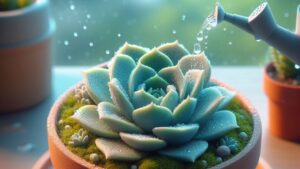
Here, the artistry lies in discovering the rhythmic cadence of watering frequency. Picture a succulent stage adorned with well-draining soil, where roots gracefully sip the moisture without lingering in it, avoiding the tragic encore of succulent leaves falling off. Instead of adhering to a rigid schedule, become the attentive conductor, monitoring the soil’s melody and bestowing hydration when it whispers the dry notes beneath your touch.
In this symphony of care, finding the perfect balance ensures that the succulent leaves dance on, resisting the melancholic descent into the refrain of succulent leaves falling off.
Overwatering vs. Underwatering
Navigating the delicate ballet of succulent care, overwatering emerges as a notorious antagonist, often orchestrating the tragic tale of succulent leaves falling off. Picture a saturated stage where the soil remains perpetually soggy, suffocating succulent roots and laying the groundwork for the somber notes of root rot.
The signs of this overwatering drama manifest in wilting, yellowing, and the mournful blackening of leaves, each note contributing to the melancholy of succulent leaves falling off.
Yet, on the opposing end of the spectrum, underwatering emerges as a silent accomplice in this botanical narrative. The arid landscape left in its wake leads to leaves withering and succumbing to the dehydrated embrace, a poignant scene of desolation where the lack of water hinders the plant’s ability to cradle its leaves, resulting in the heart-wrenching descent into the refrain of succulent leaves falling off.
In this symphony of moisture management, finding the harmonious balance becomes the key to preserving the vibrancy of succulent foliage, resisting the sorrowful cadence of succulent leaves falling off.
Proper Watering Techniques for Succulents
In the delicate rhythm of succulent care, precision in watering is paramount to prevent the haunting notes of succulent leaves falling off. A gentle reminder echoes through the botanical symphony: target the soil, not the leaves. Directing the aqueous cadence towards the leaves may summon the specters of rot and fungal infections, casting a shadow over the once-lively foliage, inevitably leading to the lament of succulent leaves falling off.
Instead, guide the water gracefully to the base of the plant, allowing it to embark on a journey that efficiently reaches the roots, sustaining the verdant ensemble.
Furthermore, let the soil embrace the sweet silence of dryness between watering sessions. This orchestrated pause mirrors the natural rainfall cycles of arid regions, a choreography that nurtures healthy root development and safeguards against the dissonance of water-related problems. Picture the soil as the stage upon which succulents perform their dance, and this strategic interlude becomes the key to preserving the vitality of the ensemble, fending off the sorrowful refrain of succulent leaves falling off.
As we transition from the aqueous movements of watering practices to the composition of the soil itself, let us unravel the pivotal role well-draining soil plays in the grand narrative of succulent health.
Soil Composition

Importance of Well-Draining Soil
In the lyrical tale of succulent care, an aversion to waterlogged soil becomes a resounding theme, resonating through the delicate notes of the botanical composition. Picture the succulent roots as musicians yearning for oxygen, their melody stifled by the suffocating embrace of waterlogged conditions, inevitably culminating in the sorrowful cascade of succulent leaves falling off.
The roots, once vibrant with life, succumb to the oppressive weight of excess moisture, rendering the ensemble bereft of its verdant notes.
Enter the stage of succulent care, where the foundational step becomes a harmonious choice of well-draining soil. This specially crafted soil, akin to a conductor’s baton, directs excess water away swiftly, preventing the haunting accumulation that could drown the roots in a watery requiem.
As the soil becomes the stage for the succulent performance, this strategic selection acts as a protective barrier against the dissonant notes of succulent leaves falling off, ensuring the continuation of a vibrant botanical symphony.
Choosing the Right Soil Mix for Succulents
In the rhythmic dance of succulent care, selecting a specialized succulent or cactus soil mix emerges as a wise overture, a melody that resonates through the botanical ensemble. These purposeful blends, orchestrated with ingredients like perlite or sand, perform a graceful choreography, enhancing drainage and fostering an environment where succulent growth flourishes without the haunting refrain of succulent leaves falling off. The soil becomes a harmonious stage, setting the scene for a verdant symphony.
Alternatively, as the conductor of your own botanical orchestra, you can craft a bespoke well-draining soil mix. Blend potting soil with perlite, coarse sand, or pumice in a composition that echoes the loose, gritty texture of nature’s serenade. This crafted medium promotes aeration, allowing the succulent roots to dance freely, while skillfully preventing the somber notes of water retention that might lead to the melancholy of succulent leaves falling off.
In this soil symphony, your arrangement becomes the safeguard against the dissonance, ensuring the longevity of a thriving succulent composition.
Soil Amendments for Optimal Succulent Growth
Elevating your soil with enhancements like perlite or coarse sand becomes a lyrical interlude in the botanical symphony, a harmonious choice that resounds through the delicate notes of succulent care. These amendments, akin to skilled musicians, sculpt air pockets within the soil, orchestrating a composition where water gracefully flows through, avoiding the ominous crescendo of succulent leaves falling off. The soil becomes a canvas for this performance, a testament to the artistry of drainage.
Embark on an experimental journey, exploring diverse soil compositions to unveil the mix that orchestrates the finest melody for your succulents. Picture this as a botanical sonnet, with the goal echoing the natural habitats where water is a rare guest, swiftly departing to prevent the mournful echo of succulent leaves falling off. In this soil symphony, mimicry becomes the key to preserving the vitality of your succulents.
With a sturdy foundation laid in soil composition, our melodic journey seamlessly transitions to pot selection—a chapter often underestimated in the grand opus of succulent care.
Pot Selection
The Role of Pot Size in Succulent Health
In the rhythmic cadence of succulent care, pot size emerges as a melodic refrain, a pivotal note in the botanical sonata. Opting for an appropriately sized pot becomes the conductor’s choice, orchestrating a composition where roots flourish without the disheartening echo of succulent leaves falling off. This vessel becomes the stage, ensuring the vitality of the succulent ensemble.
Guided by the harmonious principles, select a pot that generously offers at least an inch of space around the root ball—a poetic measure that embraces proper air circulation and gracefully minimizes the risk of succulent leaves falling off due to moisture-related problems. The pot becomes a sanctuary, a guardian of the verdant symphony within, setting the stage for a flourishing succulent performance.
Drainage Holes: A Crucial Consideration
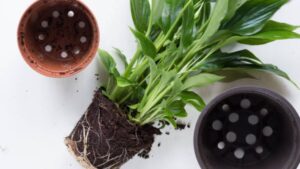
In the delicate symphony of succulent care, the melody of drainage holes echoes as a crucial refrain, a key note in the botanical composition that safeguards against the haunting rhythm of succulent leaves falling off. These openings act as vents, allowing excess water to gracefully escape and avoiding the drowning crescendo that could harm the roots and lead to the mournful descent of succulent leaves falling off.
When perusing the array of pots, elevate the importance of functionality by prioritizing those adorned with drainage holes. In this horticultural aria, the allure of a pot’s aesthetics should harmonize with the practical necessity vital for succulent health. For in the balance between decorative appeal and the virtuosity of functionality lies the secret to nurturing a flourishing succulent ensemble, free from the dissonant notes of succulent leaves falling off.
Decorative Pots vs. Practicality
In the intricate melody of succulent care, the allure of aesthetic preferences serenades us, yet it’s imperative to harmonize with practicality to prevent the disheartening rhythm of succulent leaves falling off. Decorative pots lacking drainage holes, though visually stunning, pose a substantial risk to your succulents, creating a potential symphony of issues.
For those enamored with a drainage-deficient pot, consider it as an outer shell, a protective layer for the inner sanctum of your succulent. Nestle a smaller, well-draining pot within the decorative one, a duet that allows you to revel in visual charm while orchestrating optimal conditions for your plant, safeguarding against the haunting notes of succulent leaves falling off.
As we conclude our exploration of pot selection, we seamlessly transition to a topic often overlooked until it becomes a discordant note: pests and diseases.
Pests and Diseases
Identifying Common Succulent Pests
Vigilance is key when it comes to succulent pests. Common culprits include aphids, mealybugs, and spider mites. Regularly inspect the leaves, especially the undersides, where pests often hide.
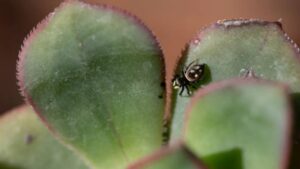
Aphids: These tiny insects can quickly multiply, causing leaf distortion and discoloration.
Mealybugs: Recognizable by their cottony appearance, mealybugs feed on sap, leading to stunted growth and leaf loss.
Spider Mites: These minuscule pests leave a fine webbing on plants and suck out vital fluids, causing leaves to turn yellow and drop.
Preventive Measures Against Pest Infestations
In the vigilant choreography of succulent care, preventing the intrusion of pests becomes a paramount movement to ward off the disheartening refrain of succulent leaves falling off. Establishing a routine inspection emerges as the vigilant overture, where a gentle spray of water or a delicate application of insecticidal soap becomes the conductor’s baton, aiming to dislodge the unwanted guests like aphids and mealybugs that threaten the verdant ensemble. Picture this as a botanical cleansing, washing away the potential sorrow of succulent leaves falling off.
For the clandestine invaders known as spider mites, introduce the benevolent players of this botanical drama, such as ladybugs, to restore the harmonious balance. In this insect ballet, these natural predators gracefully take center stage, preserving the vitality of your succulents and fending off the discordant notes of succulent leaves falling off.
As we navigate through the measures to safeguard against succulent pests, a crucial encore lies in maintaining a pristine environment. Sweep away debris from around your succulents, clearing the stage of fallen leaves and detritus where pests often seek refuge. In this meticulous orchestration, the dance floor remains uncluttered, sparing your succulents from the potential melancholy of succulent leaves falling off.
Recognizing and Treating Succulent Diseases
Fungal infections can wreak havoc on succulents, leading to leaf discoloration and drop. Common diseases include root rot, powdery mildew, and fungal leaf spots.
Root Rot: Caused by overly wet conditions, root rot manifests as mushy, discolored roots. Cut away affected parts and repot in well-draining soil.
Powdery Mildew: A white, powdery substance on leaves indicates powdery mildew. Remove affected leaves and treat with a fungicide.
Fungal Leaf Spots: Irregular spots with a dark edge signal a fungal infection. Prune affected leaves and apply a fungicide.
With our succulents protected from pests and diseases, let’s shift our focus to another critical aspect: repotting practices.
Repotting Practices
Signs It’s Time to Repot Your Succulent
Repotting is a rejuvenating process that provides succulents with fresh soil and ample space for root growth. Recognizing when it’s time to repot is crucial:
- Overcrowded Roots: If the roots have filled the pot, causing a dense, tangled mass, it’s time to repot.
- Sluggish Growth: If your succulent’s growth has slowed or stagnated, new soil can provide renewed nutrients.
- Watering Issues: If water runs straight through the pot without being absorbed, the soil may be compacted, necessitating repotting.
Step-by-Step Guide to Safe Succulent Repotting
- Prepare the New Pot: Select a pot with drainage holes slightly larger than the current one.
- Remove the Succulent: Gently tip the pot and coax the succulent out. If roots are tightly bound, loosen them with care.
- Inspect and Trim Roots: Trim any dead or rotting roots. Healthy roots are firm and white or light-colored.
- Add Fresh Soil: Fill the new pot with well-draining soil, leaving enough space for the roots.
- Place the Succulent: Center the succulent in the new pot, adjusting the soil level as needed.
- Water Sparingly: Wait a few days before watering to allow any damaged roots to heal.
Post-Repotting Care Tips
After repotting, place the succulent in indirect light to reduce stress. Resume regular watering after a few days, allowing the plant to acclimate to its new environment.
With the knowledge of repotting practices in our arsenal, let’s explore how stress can impact succulents.
Stress and Succulents
Impact of Stress on Succulent Health
In the resilient serenade of succulent care, even these hardy plants can succumb to the poignant notes of stress. Whether triggered by environmental changes, the intrusion of pests, diseases, or insufficient care, stress can cast a shadow over the botanical performance, potentially resulting in a cascade of issues, with the melancholic refrain of succulent leaves falling off. These captivating plants, though stalwart, remind us that their well-being hinges delicately on the harmony of their surroundings and the meticulous care extended to them.
Minimizing Stress Factors for Thriving Succulents
In the gentle ballad of succulent care, the key to preserving harmony is found in the cadence of consistent routines. To mitigate stress, refrain from orchestrating abrupt changes in light exposure, temperature, or watering frequency, allowing these resilient plants to gracefully sway to the familiar melody of stability. By tending to the delicate choreography of their environment, you can prevent the mournful notes of succulent leaves falling off. Keep a vigilant gaze, ever watchful for the subtle intruders—pests—and promptly attend to any whispers of disease. In this symphony of meticulous care, you ensure that the succulent ensemble thrives, free from the dissonance of succulent leaves falling off.
Adapting to Environmental Changes
In the graceful dance of succulent care, adaptation to environmental changes is a virtue, yet the delicate sway of gradual transitions is the symphony’s secret. When contemplating a change in your succulent’s location, serenade it with acclimation, a gradual crescendo or decrescendo of light exposure over the span of a week.
This harmonious approach ensures that your succulent adapts seamlessly, avoiding the melancholic notes of succulent leaves falling off that may arise from abrupt shifts.
As our succulents continue to flourish under these optimal conditions, let us now embark on the next movement—a graceful exploration into rescuing drooping leaves.
Tips for Rescuing Drooping Leaves
Immediate Actions to Salvage Drooping Succulent Leaves
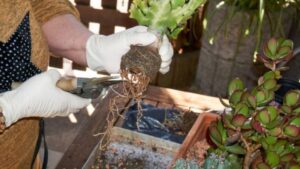
Drooping leaves can be distressing, but swift action can often save your succulent:
- Assess Light Conditions: Ensure your succulent receives adequate, indirect sunlight. Adjust its placement if needed.
- Check Soil Moisture: Overwatering or underwatering can lead to drooping. Adjust watering based on the soil’s moisture level.
- Inspect for Pests: Pests can cause stress, leading to drooping leaves. Check for signs of aphids, mealybugs, or spider mites.
Long-Term Strategies for Healthy Succulent Growth
- Optimize Light Exposure: Ensure your succulent receives the right amount of sunlight for its species. Adjust the location as seasons change.
- Fine-Tune Watering: Establish a consistent watering schedule, allowing the soil to dry between sessions. Adjust based on seasonal requirements.
- Monitor for Pests: Regularly inspect your succulents for pests. Early detection and intervention can prevent widespread damage.
Patience and Observation: Keys to Successful Succulent Care
In the gentle melody of succulent care, patience and keen observation compose the harmonious notes that guide this botanical journey. As you weave these tips into the symphony of nurturing, keep in mind that succulents are slow dancers, gracefully responding to changes at their own pace.
Patience becomes the conductor’s wand, preventing the disheartening crescendo of succulent leaves falling off that may arise from rushed adjustments. Observe their delicate choreography, attune your senses to their subtle cues, and modulate care routines accordingly to ensure a vibrant, flourishing performance.
As we gracefully approach the conclusion of this comprehensive guide, let us revel in the uplifting crescendo of success stories and testimonials from fellow succulent enthusiasts. In this collective celebration, the shared experiences become the verses of a joyful anthem, echoing the triumphs of succulent care and the beauty they bring to the lives of those who cherish them.
Success Stories and Testimonials
Real-Life Experiences: Navigating the Symphony of Succulent Leaves Falling Off
In the global symphony of succulent care, enthusiasts from every corner of the world share their poignant tales of triumph over the lament of succulent leaves falling off. These narratives unfold like melodic verses, revealing the collective wisdom gained in identifying environmental stressors and implementing targeted care strategies.
Through these shared experiences, the resilience of succulents becomes an inspiring crescendo, echoing the dedication and passion of their caregivers who orchestrate the botanical ballad.
In each success story, the once melancholic refrain of succulent leaves falling off transforms into a harmonious melody, a testament to the enduring beauty nurtured through knowledge, care, and shared passion.
How Implementing Proper Care Transformed Succulent Health
In the heartwarming symphony of succulent care, enthusiasts frequently underscore the transformative prowess embedded in attentive nurturing. Through the delicate orchestration of fine-tuning watering routines, harmonizing light exposure, and crafting a stage with well-draining soil, succulent keepers unveil tales of remarkable recoveries.
The once sorrowful sight of drooping leaves metamorphoses into a proud display, a living testament to the positive impact that tailored care can wield. This botanical melody resonates with the echoes of resilience, showcasing how a dedicated and informed approach can rescue succulents from the brink of succulent leaves falling off, transforming their story into a triumphant anthem of renewed vitality.
Inspiring Succulent Enthusiasts’ Journeys
Embarking on a succulent care journey is a rewarding experience filled with learning and growth. Inspiring stories from succulent enthusiasts underscore the importance of patience, observation, and a genuine passion for these unique plants.
These narratives often emphasize the beauty of adaptation, as succulents prove their resilience in diverse environments. From window sills to outdoor gardens, enthusiasts share how they’ve tailored care practices to suit the specific needs of their succulents, resulting in flourishing, vibrant foliage.
As we celebrate these success stories, it’s crucial to address common questions and concerns that arise in the world of succulent care. Let’s delve into a set of frequently asked questions (FAQs) to provide comprehensive guidance.
FAQs About Succulent Care
How often should I water my succulents?
Succulents thrive in well-draining soil. Water when the top inch of soil feels dry to the touch, typically every 1-2 weeks. Adjust frequency based on factors like humidity, season, and the specific needs of your succulent species.
What are the signs of overwatering succulents?
Overwatering manifests as soft, mushy leaves, blackened or translucent areas, and a foul odor from the soil. Monitor soil moisture and ensure proper drainage to prevent overwatering-related issues.
Can I save a succulent with falling leaves?
Yes, early intervention is crucial. Identify and address the underlying cause, whether it’s environmental stress, pests, or watering issues. Adjust care practices, repot if necessary, and provide support for drooping leaves. Patience is key in the recovery process.
Are there specific succulents more prone to leaf loss?
Certain succulent varieties may be more sensitive to environmental changes. Species like Echeveria, Haworthia, and Sedum are known for their susceptibility to stress-related leaf issues. However, with proper care, any succulent can thrive.
What role does fertilization play in succulent care?
Succulents have low nutrient requirements. Fertilize sparingly, using a balanced, water-soluble fertilizer diluted to half or quarter strength. Apply during the growing season (spring and summer) and avoid fertilizing during dormancy in winter.
Conclusion
In our comprehensive exploration of succulent care, we’ve uncovered the secrets behind succulent leaves falling off. From understanding the intricacies of succulent anatomy to navigating environmental factors, watering practices, soil composition, and pot selection, each aspect plays a crucial role in the overall health of these resilient plants.
As you embark on your succulent care journey, remember that success is a continuous process of observation, adaptation, and dedication. Celebrate the unique beauty of each succulent, learning from both challenges and triumphs. By embracing the principles outlined in this guide, you’ll foster an environment where succulents thrive, showcasing vibrant leaves and resilient growth.
